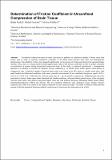| dc.contributor.author | Rashid, Badar | |
| dc.contributor.author | Destrade, Michel | |
| dc.contributor.author | Gilchrist, Michael | |
| dc.date.accessioned | 2013-03-11T10:32:21Z | |
| dc.date.available | 2013-03-11T10:32:21Z | |
| dc.date.issued | 2012-10 | |
| dc.identifier.citation | Badar Rashid, Michel Destrade, Michael Gilchrist (2012) 'Determination of friction coefficient in unconfined compression of brain tissue'. Journal Of The Mechanical Behavior Of Biomedical Materials, 14 :163-171. | en_US |
| dc.identifier.issn | 1751-6161 | |
| dc.identifier.uri | http://hdl.handle.net/10379/3287 | |
| dc.description.abstract | Unconfined compression tests are more convenient to perform on cylindrical
samples of brain tissue than tensile tests in order to estimate mechanical
properties of the brain tissue because they allow for homogeneous deformations.
The reliability of these tests depends significantly on the amount of friction
generated at the specimen/platen interface. Thus, there is a crucial need to
find an approximate value of the friction coefficient in order to predict a
possible overestimation of stresses during unconfined compression tests. In this
study, a combined experimental-computational approach was adopted to estimate
the dynamic friction coefficient mu of porcine brain matter against metal
platens in compressive tests. Cylindrical samples of porcine brain tissue were
tested up to 30% strain at variable strain rates, both under bonded and
lubricated conditions in the same controlled environment. It was established
that mu was equal to 0.09 +/- 0.03, 0.18 +/- 0.04, 0.18 +/- 0.04 and 0.20 +/-
0.02 at strain rates of 1, 30, 60 and 90/s, respectively. Additional tests were
also performed to analyze brain tissue under lubricated and bonded conditions,
with and without initial contact of the top platen with the brain tissue, with
different specimen aspect ratios and with different lubricants (Phosphate Buffer
Saline (PBS), Polytetrafluoroethylene (PTFE) and Silicon). The test conditions
(lubricant used, biological tissue, loading velocity) adopted in this study were
similar to the studies conducted by other research groups. This study will help
to understand the amount of friction generated during unconfined compression of
brain tissue for strain rates of up to 90/s. | en_US |
| dc.description.sponsorship | IRCSET | en_US |
| dc.format | application/pdf | en_US |
| dc.language.iso | en | en_US |
| dc.publisher | Elsevier | en_US |
| dc.relation.ispartof | Journal Of The Mechanical Behavior Of Biomedical Materials | en |
| dc.rights | Attribution-NonCommercial-NoDerivs 3.0 Ireland | |
| dc.rights.uri | https://creativecommons.org/licenses/by-nc-nd/3.0/ie/ | |
| dc.subject | Tissue | en_US |
| dc.subject | Computational | en_US |
| dc.subject | Ogden | en_US |
| dc.subject | Dynamic | en_US |
| dc.subject | Specimen | en_US |
| dc.subject | Lubricant | en_US |
| dc.subject | Bonded | en_US |
| dc.subject | Platen | en_US |
| dc.title | Determination of friction coefficient in unconfined compression of brain tissue | en_US |
| dc.type | Article | en_US |
| dc.date.updated | 2013-03-11T10:27:02Z | |
| dc.identifier.doi | http://dx.doi.org/10.1016/j.jmbbm.2012.05.001 | |
| dc.local.publishedsource | http://dx.doi.org/10.1016/j.jmbbm.2012.05.001 | en_US |
| dc.description.peer-reviewed | peer-reviewed | |
| dc.contributor.funder | |~|IRCSET|~| | |
| dc.internal.rssid | 3623918 | |
| dc.local.contact | Michel Destrade, Room C202 Áras De Brún, School Of Mathematics, Nui Galway. Email: michel.destrade@nuigalway.ie | |
| dc.local.copyrightchecked | Yes | |
| dc.local.version | ACCEPTED | |
| nui.item.downloads | 775 | |


